Protect your beautiful butcher block countertop with a food safe sealer.
Butcher block countertops are so classic. But they need to be sealed to protect the wood from staining and water damage.
There are many different ways to seal your butcher block. If you want a strong, waterproof finish that does not add any gloss or alter the appearance of your countertop, then you came to the right place!
I partnered with Waterlox to seal my new butcher block countertop with their TrueTone Buff-in Tung Oil finish. This easy to apply finish seals and protects the wood without the look of a polyurethane coating. It gives it a matte, unfinished look.
This post may contain affiliate links. As an Amazon Associate I earn from qualifying purchases. Click here to read my full disclosure policy.
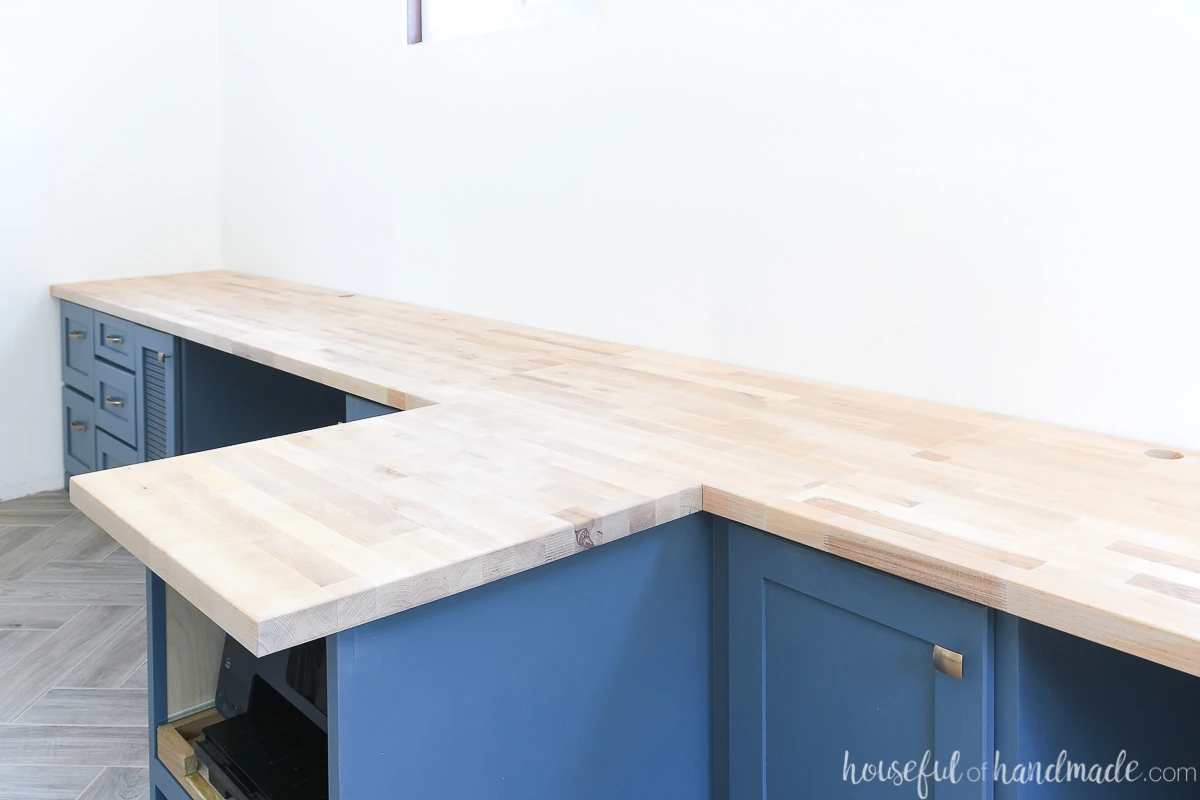
Learn how to install butcher block countertops here.
If you want a more traditional finish on your countertop (one with a visible film), check out how to seal a wood countertop here or how to seal a wood vanity top here.
Best Finish for Butcher Block Countertops
From all the different options for sealing butcher block, I chose the Waterlox TrueTone sealer because of it’s matte, unfinished look and water-resistant finish. It also is low VOC and low odor which is great since it is applied in the home
Plus you can change the color of your butcher block! The first layer in the TrueTone series is a Color-infused Tung Oil stain. There are 11 options to choose from. You can see the stain colors tested on different woods here.
If you want to keep your butcher block light (like I did), so that it does not darken as much once the finish/sealer is applied, use the White colored stain.
It has a little bit of warmth added, but give the countertop a mostly unfinished look. If you want the warmth of a finished wood, you use the Natural color first.
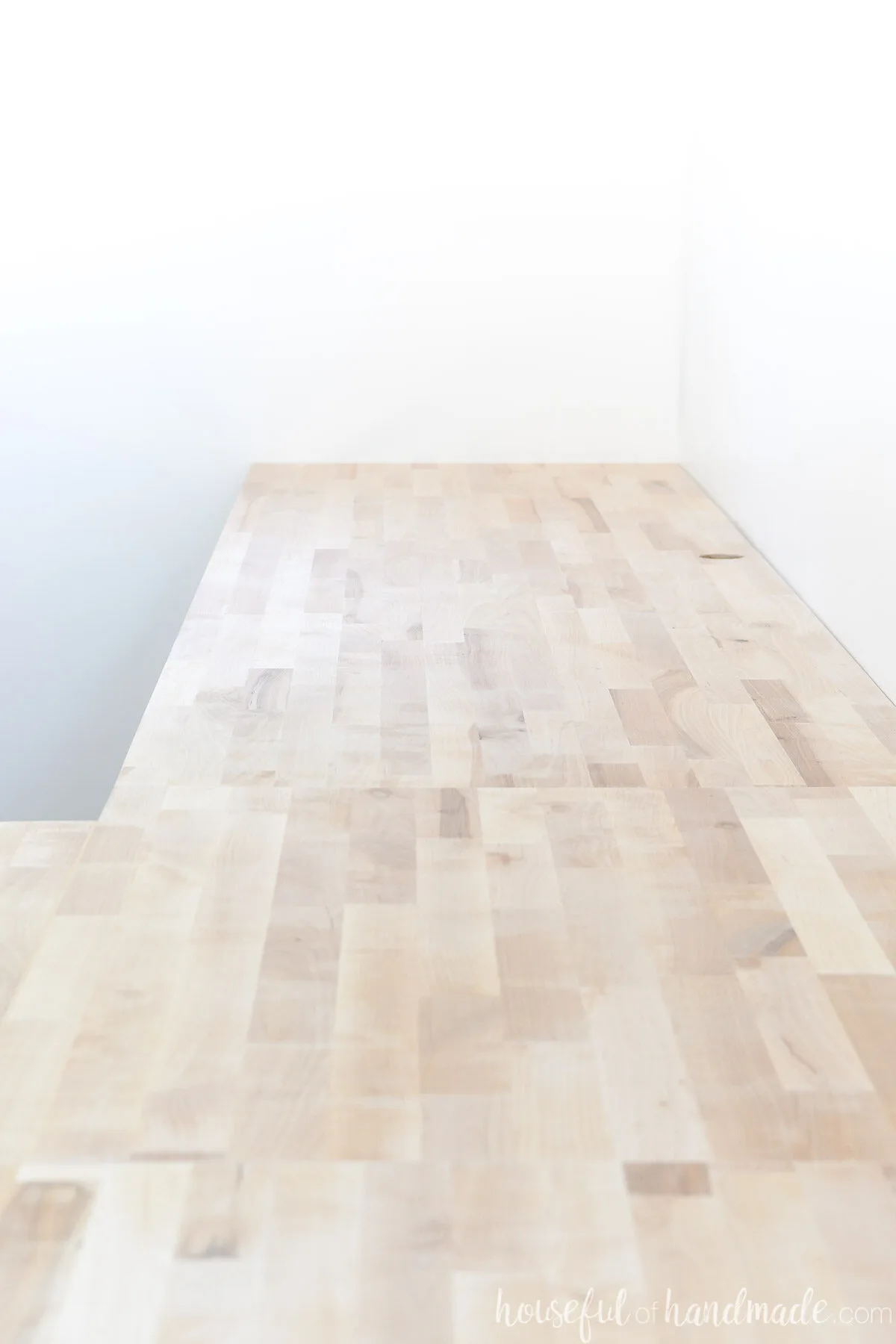
Then you finish off the butcher block with 2-3 coats of the TrueTone finish. This creates a penetrating seal on your countertop with a truly matte finish.
One of the best parts of the TrueTone finish is how easy it is to reapply/refresh your sealer if needed:
- No sanding needed, but you can sand out scratches/dings if you want.
- Thoroughly clean the surface.
- Reapply TrueTone color if needed to the area.
- Buff-in TrueTone finish to the area.
- Reapply coats as needed until the wood looks refreshed.
- Let dry 24 hours between coats.
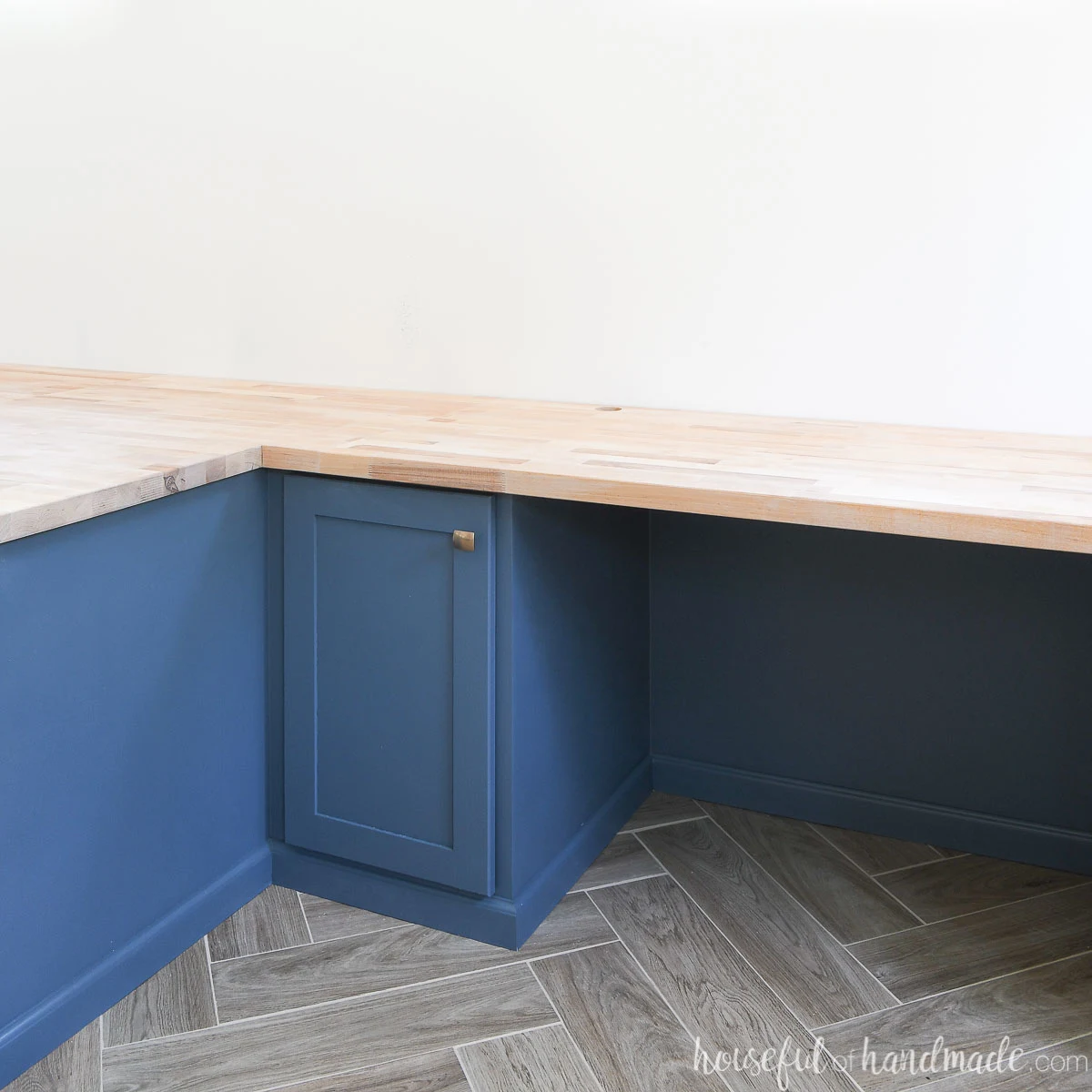
How to Determine How Much Sealer You Need?
Figuring out how much stain or sealer to purchase can be frustrating.
You don’t want to run out mid-project because you didn’t buy enough. But you also do not want to buy too much and waste money.
To figure out how much sealer you need, you need to determine the square footage of your countertop.
Measure the length and the width of your countertop. If you have a peninsula, measure it as a separate piece.
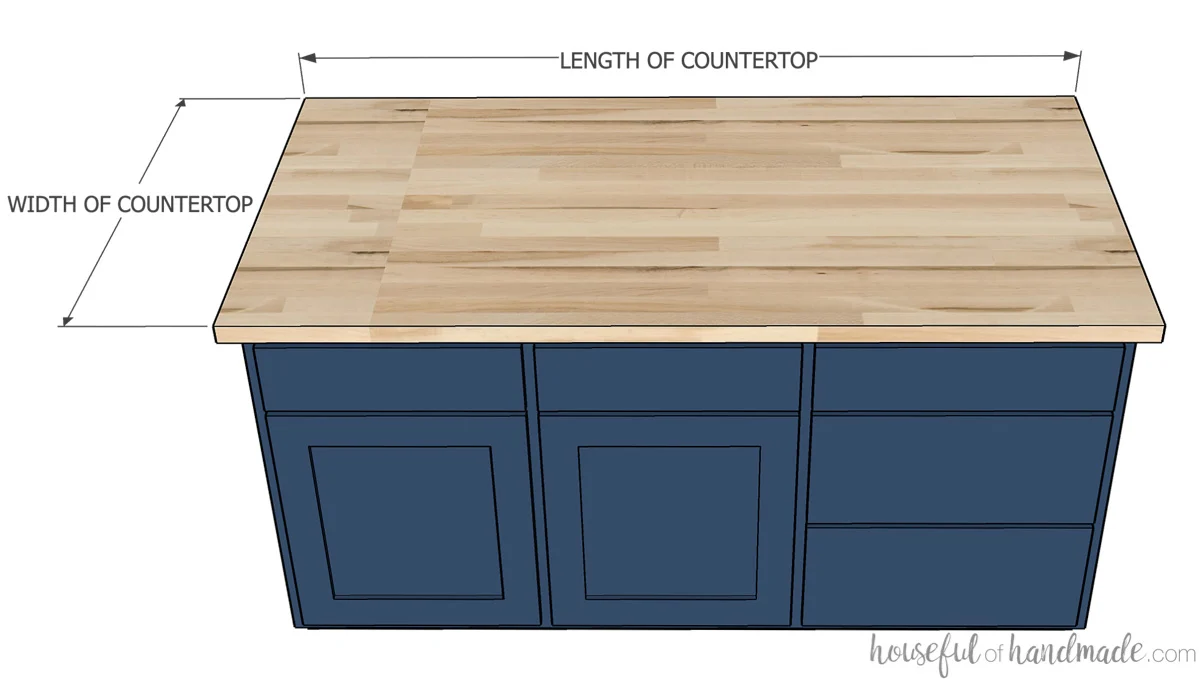
Use the following formula to determine how many square feet each section is:
Length (in feet) X Width (in feet) = Square Feet
To convert a measurement in inches to feet, just divide the total in inches by 12. So a 25″ wide countertop would be 2.08 feet. And a 68″ long countertop is 5.67 feet.
The square feet is the total per side of the countertop. If you want to seal the underside of the countertop you will need to double that number.
Figure out the square feet for every section of countertop then add them together.
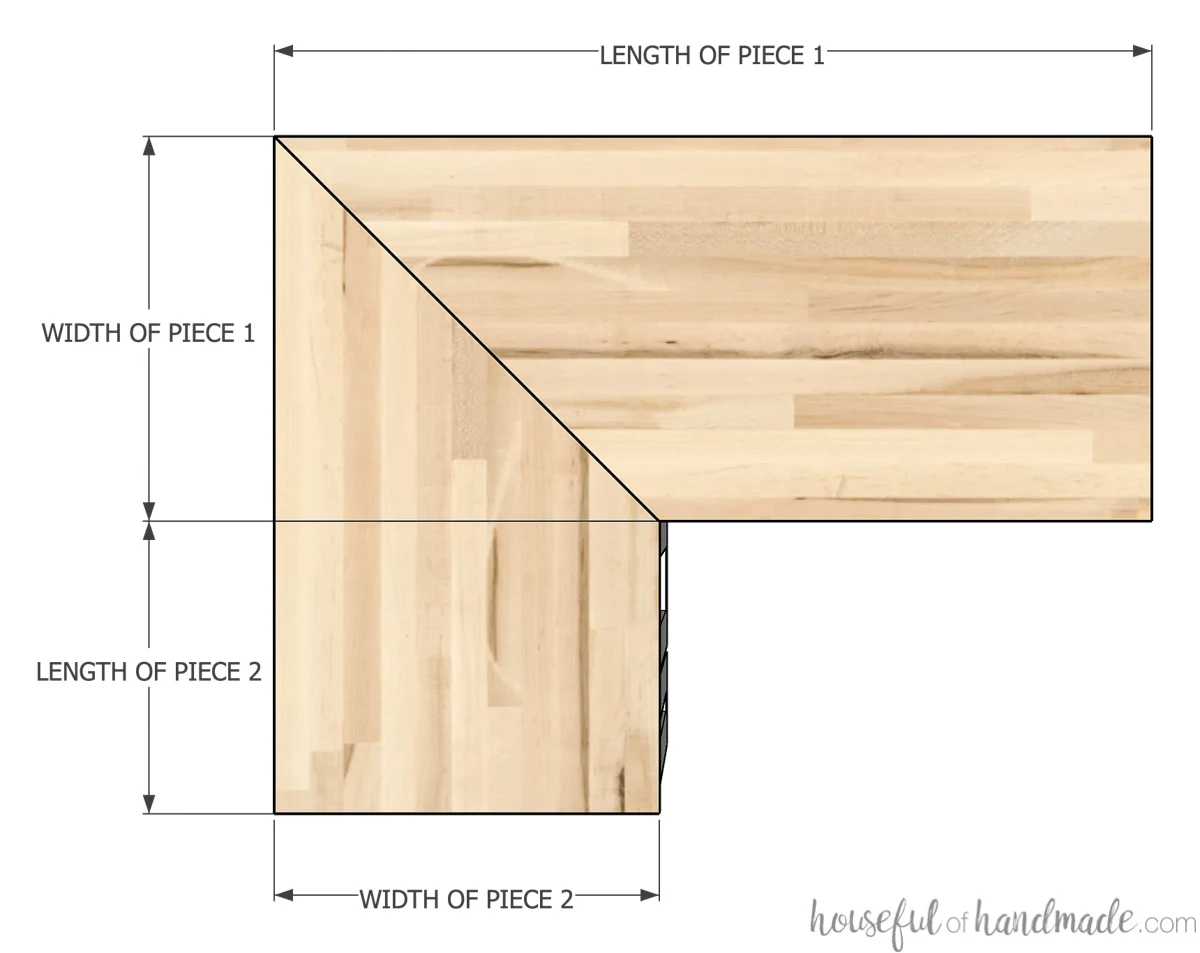
Each sealer/paint should have a note stating how many square feet it covers per coat. For Waterlox TrueTone:
- One gallon covers 3,200 square feet per coat.
- One quart covers 800 square feet per coat.
- One pint covers 300 square feet per coat.
- One 2 oz covers 25 square feet per coat.
Make sure to purchase enough product to get the correct amount of coats.
My countertop was 45 square feet so I used two 2 oz containers of the stain and one pint container for the 3 coats of finish.
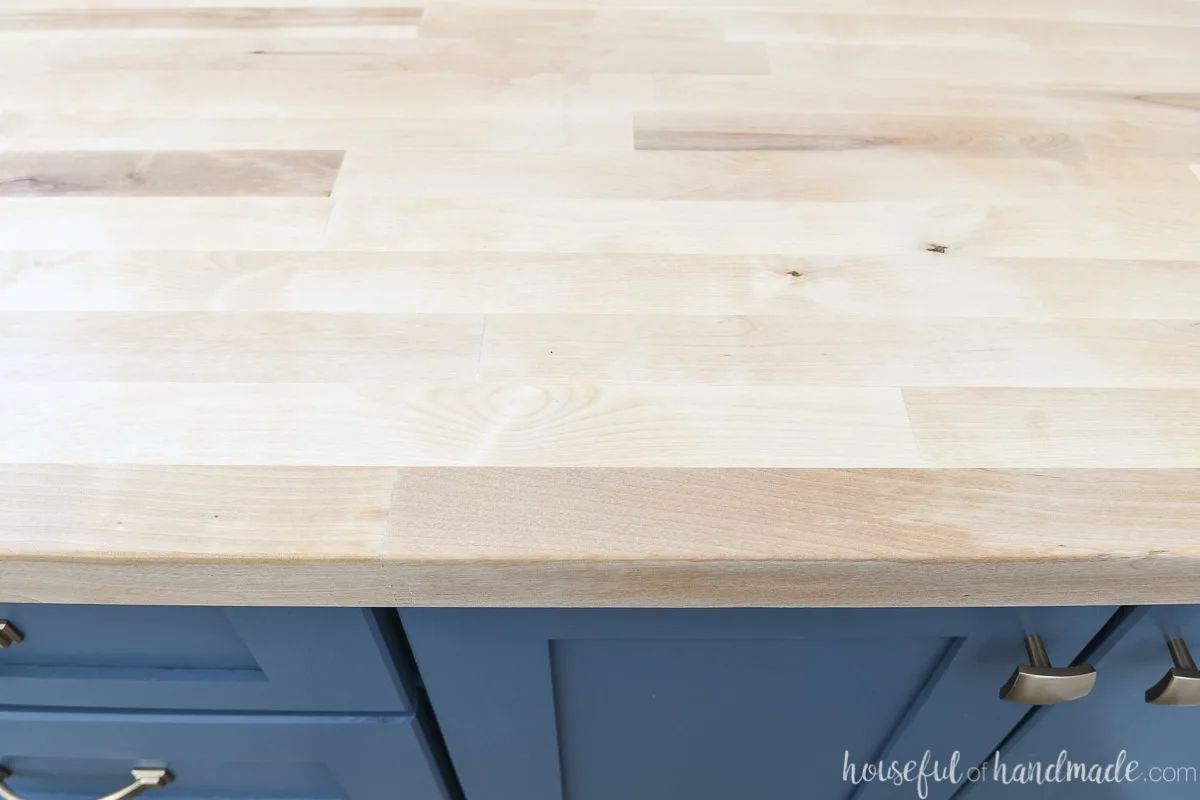
How to Seal Wood Countertops
Tools:
- Sander
- Fan
Supplies:
- TrueTone Color Infused Tung Oil Stain
- TrueTone Buff In Finish
- Sandpaper up to 100-150 grit
- Mineral spirits or tack cloth
- Lint free rags
- Gloves
STEP 1- Sand and Prep Countertop
To prepare the countertop, you will want to cut any holes into it before finishing. These include holes for faucets or cords and an opening for a sink.
Make sure to apply finish inside the holes/openings to protect that wood from water as well.
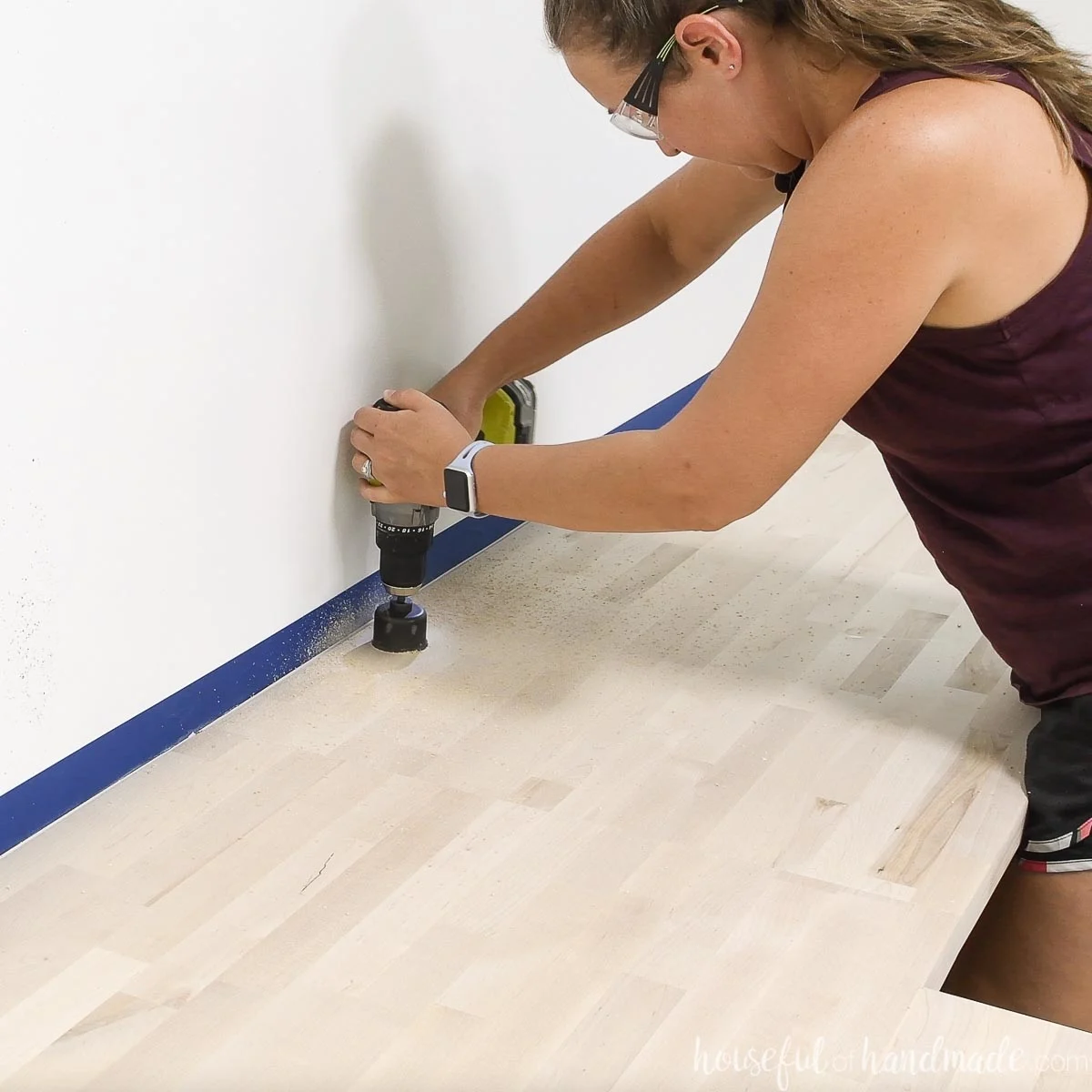
Sanding the butcher block properly before application is very important. You need to sand the entire surface evenly to 100-150 grit. Too high of a grit will cause the stain and sealer not to be able to soak into the wood.
Sanding with an orbital sander is what I do, but you have to be careful!
Orbital sanders can over sand some areas creating to smooth of a surface. Use the orbital sander on a lower speed setting to prevent this.
EXPERT TIP: If you notice after applying the stain that there are areas that are not taking the color well, they could be over sanded. Hand sand them with the 100-150 grit sandpaper to open the surface up to accept the stain.
After the sanding is done, vacuum the surface to remove dust. Then either wipe the surface with a cloth dampened with mineral spirits or use a tack cloth to wipe away the remaining dust.
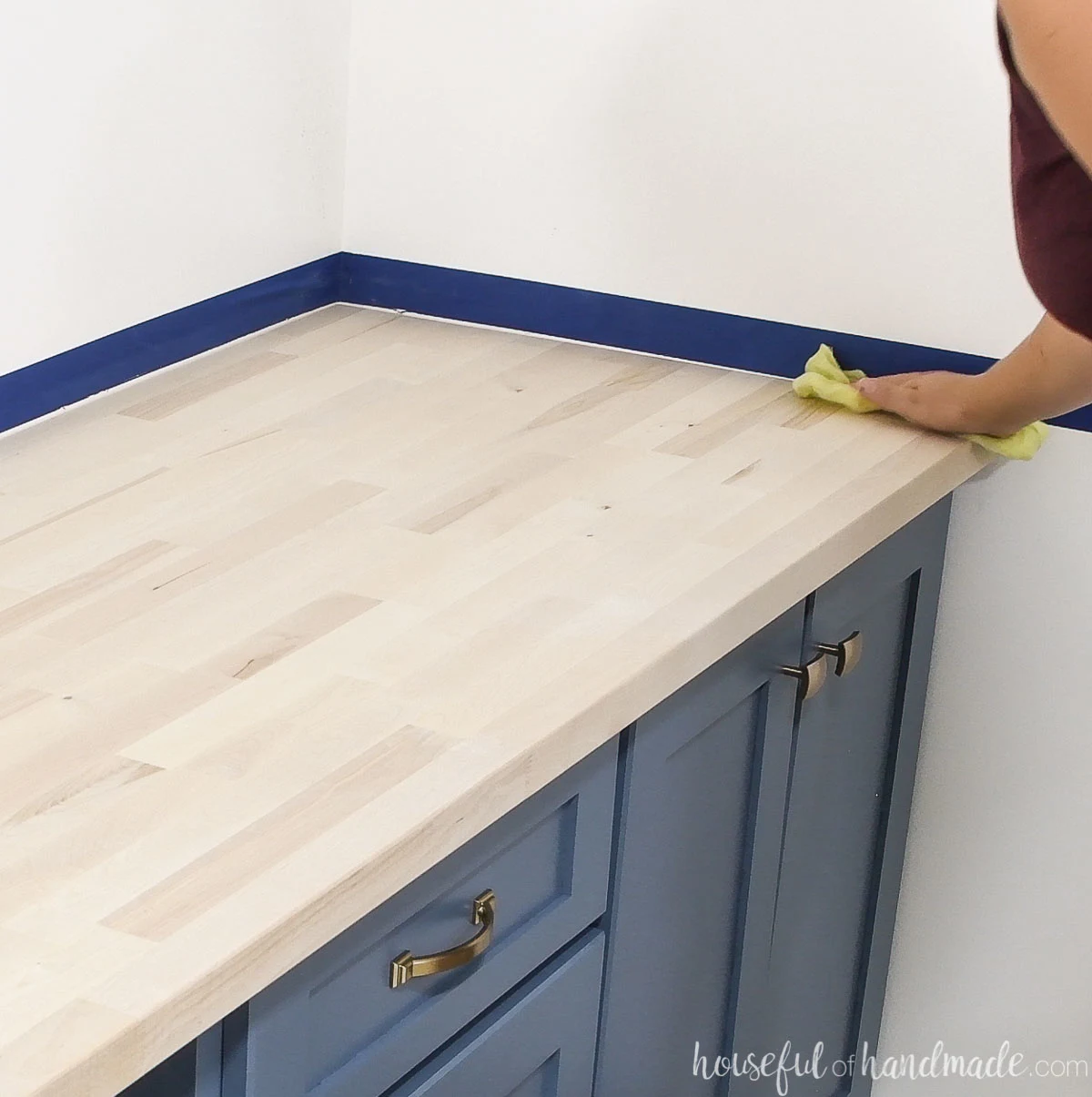
Tape off the area around the countertop. But be aware, I used a cheap painters and had to remove it after a minute since the blue color was transferring to my rag and I didn’t want it to transfer to my wood.
STEP 2- Apply Stain
To apply the TrueTone color infused stain on your countertop, you will need 2 lint free rags. One will be used to buff the color into the wood. The other is to remove the excess.
Start by pouring a small puddle on the butcher block. Then rub it into the wood.
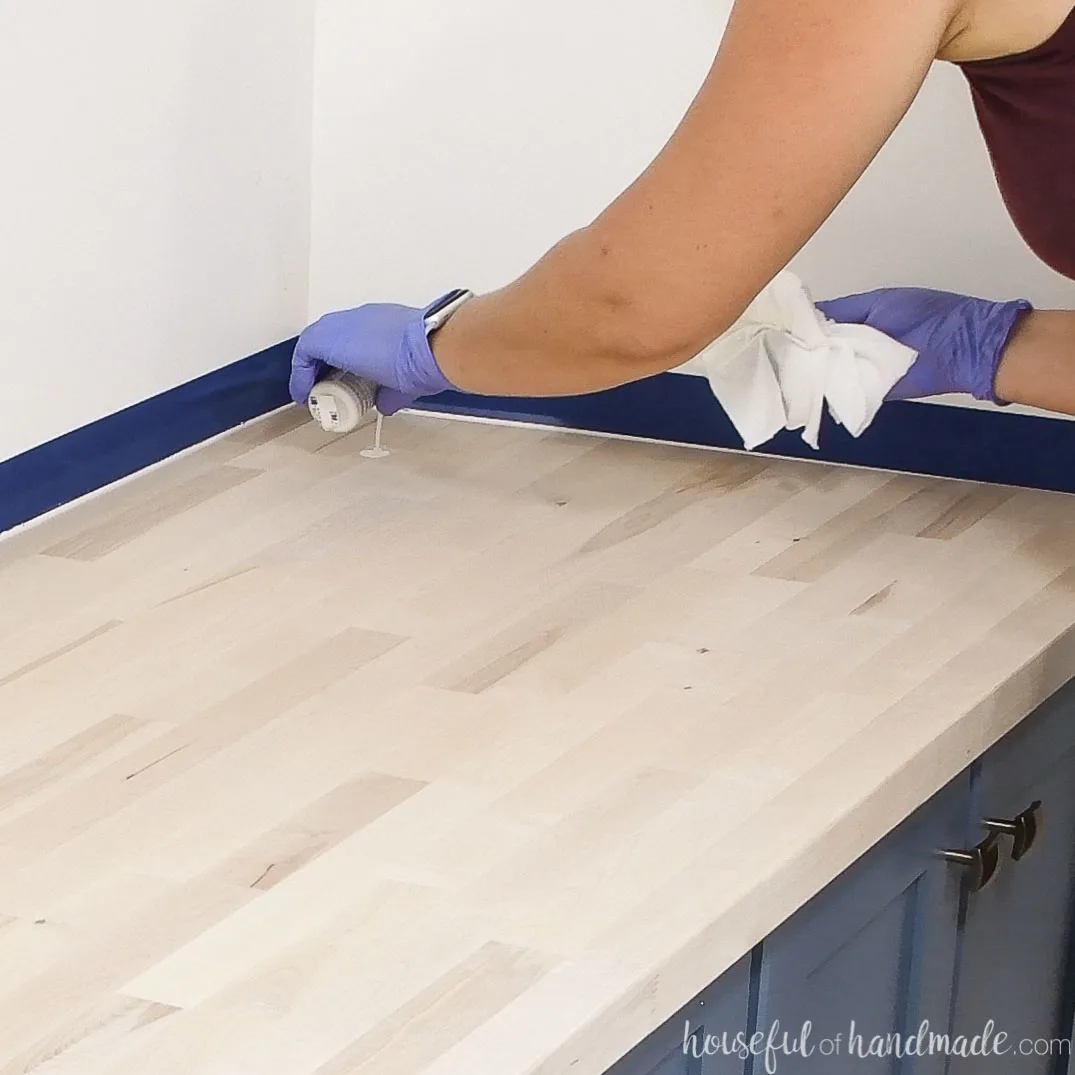
Do not wipe, the color needs to be rubbed into the wood. Continue to rub the stain into the wood, adding more product as needed.
You will notice in these pictures that you cannot tell where the White stain is applied. It barely changes the appearance of the wood.
Keep track of where you are applying the stain so you don’t miss any parts of your countertop.
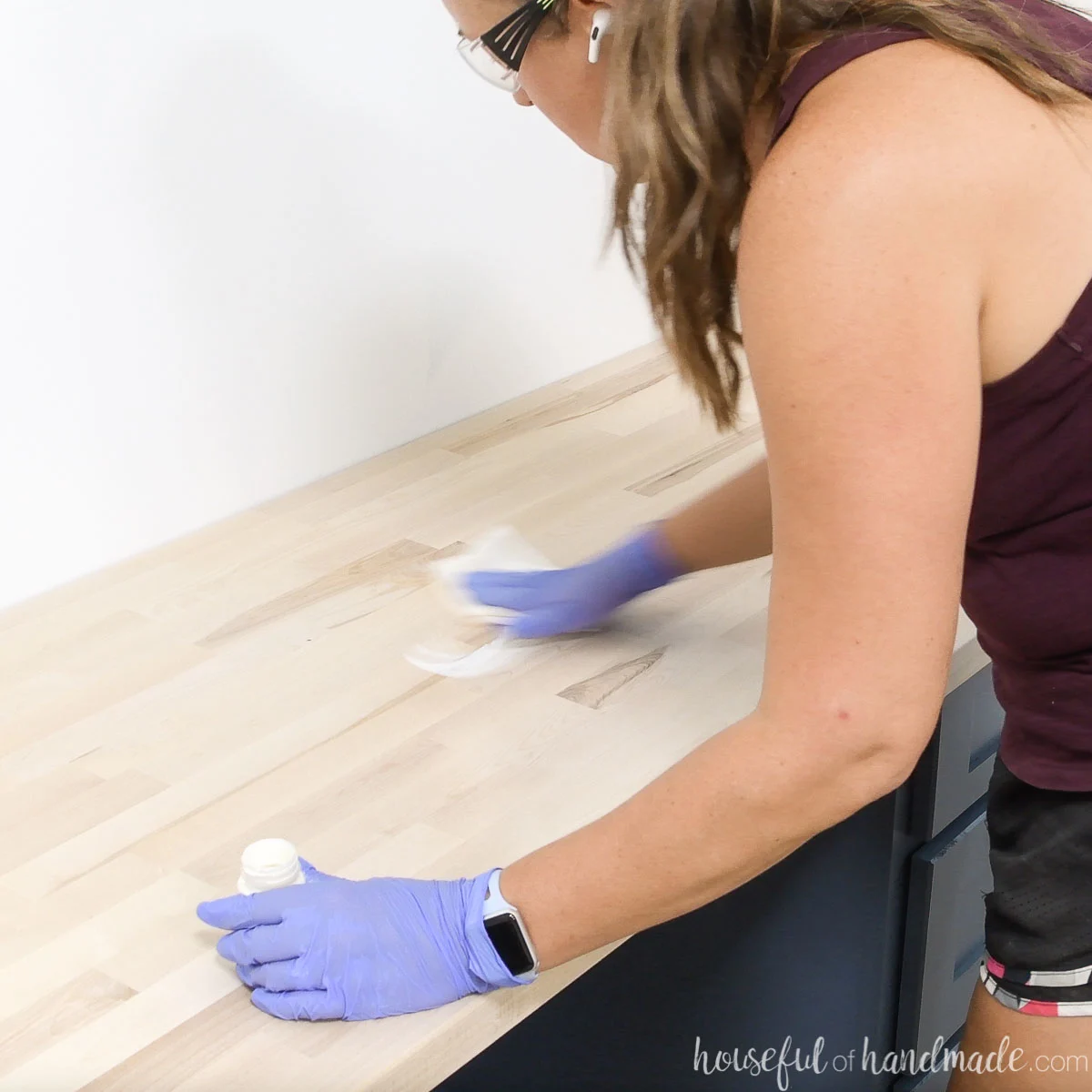
At the beginning, you will use more product. As the rag gets saturated, you will be adding product less frequently.
Make sure to apply stain inside holes, on the front and under the lip of the countertop, on the sides of the sink opening and even under the lip of the sink opening.

Do not any product that does not soak in dry on the wood. After 15 minutes, go over the area with the second rag to remove any excess.
If you are working on a large countertop, make sure to check back on the areas that have been stained for 15 minutes as you go to remove the excess product before it dries.
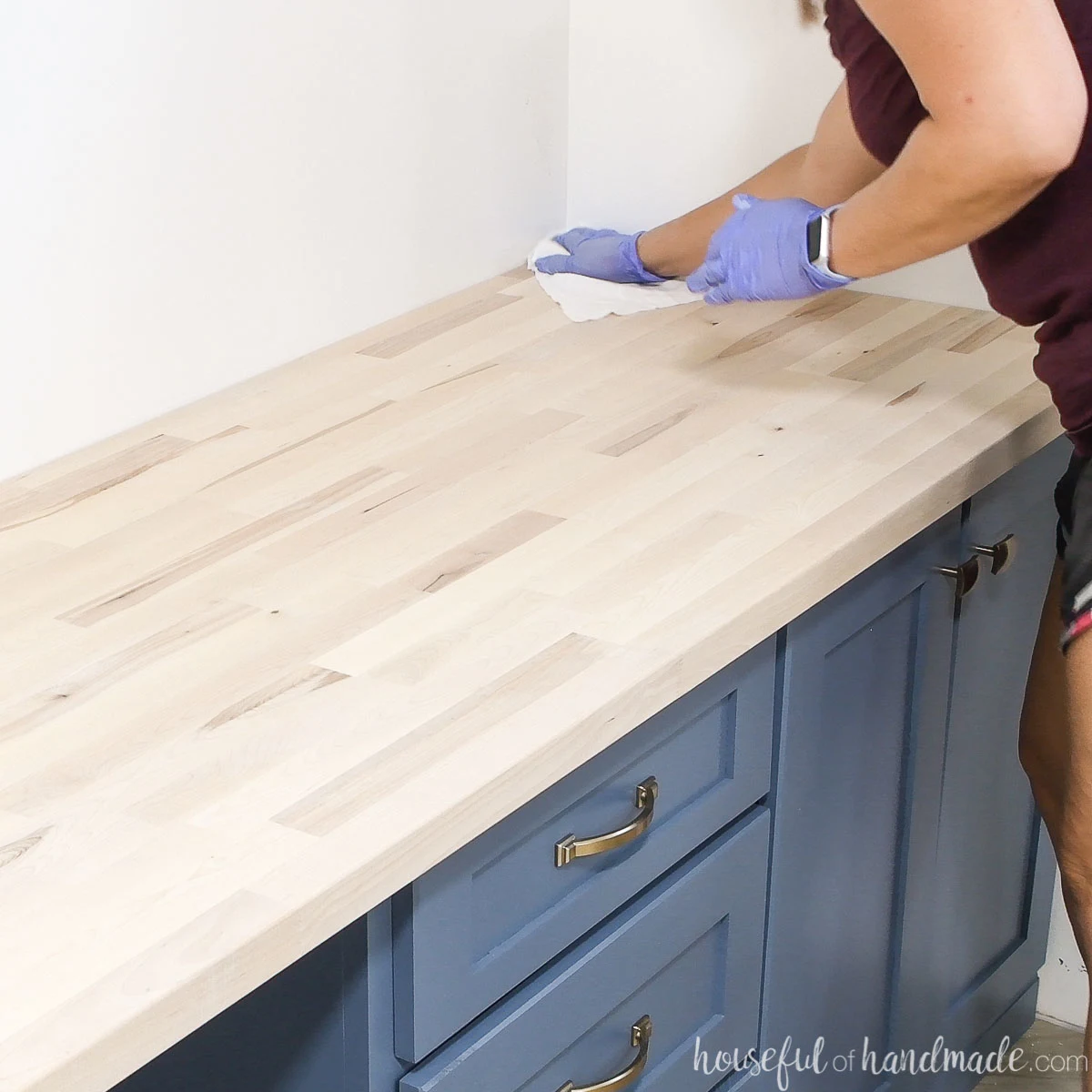
With plenty of airflow (open windows and use a fan), allow the stain to dry for 24 hours once finished.
STEP 3- Apply Finish
After the stain has dried for 24 hours, you are ready to apply the first coat of TrueTone finish to the butcher block.
The wood countertop sealer is applied the same way as the color.
You will want 2 lint free rags. Use one to buff in the finish and the other to remove the excess.
Again, the finish needs to be rubbed into the wood, not just wiped on. Apply a puddle of finish on your butcher block and buff it in with a rag.

After 15 minutes, use the other rag to buff off any excess so it does not dry on the wood. You only want to leave finish that has soaked in.
Allow the sealer to dry on the wood for 24 hours. Again, you need oxygen to cure the product so open up a couple windows (a cross breeze is best) and turn on a fan or two.
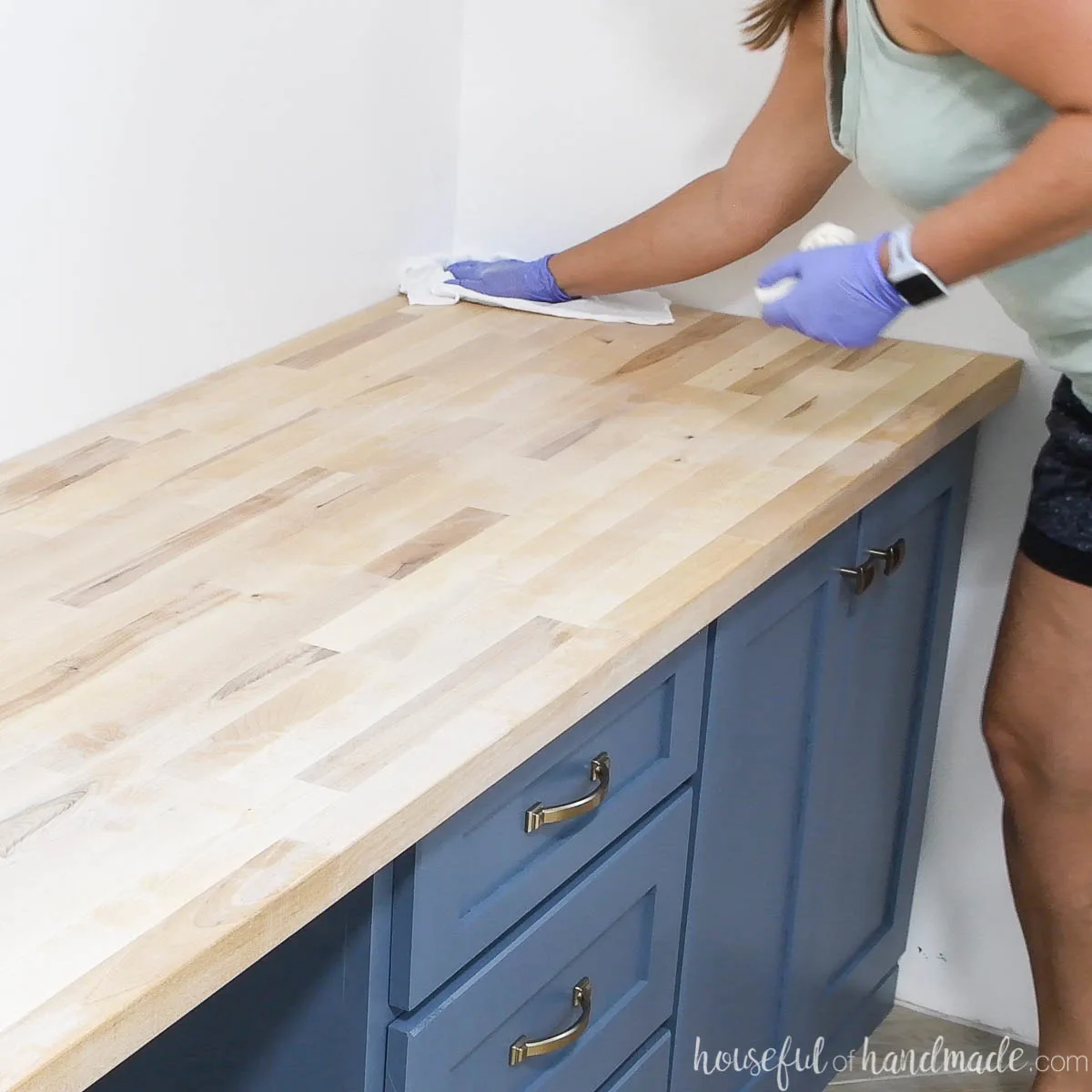
Reapply 1-2 more coats of finish on your butcher block. If you have a really oily hardwood you may only need 2 coats. But for most countertops, 3 coats is a good idea.
STEP 4- Let the Sealer Cure
The TrueTone finish cures from Oxygen. The top will be dry to the touch almost immediately, but the oxygen takes a bit longer to penetrate and cure the finish in the wood.
I would suggest waiting 24 hours before light use of the countertops. And wait at least 7-14 days before leaving things on the countertop for long periods of time (like small appliances).
These appliances could block the airflow and make it hard for the finish to properly cure. It could cause discoloration from the area that is not covered.
To take care of your butcher block sealer, use mild cleaners. Harsh cleaners can wear out the finish.
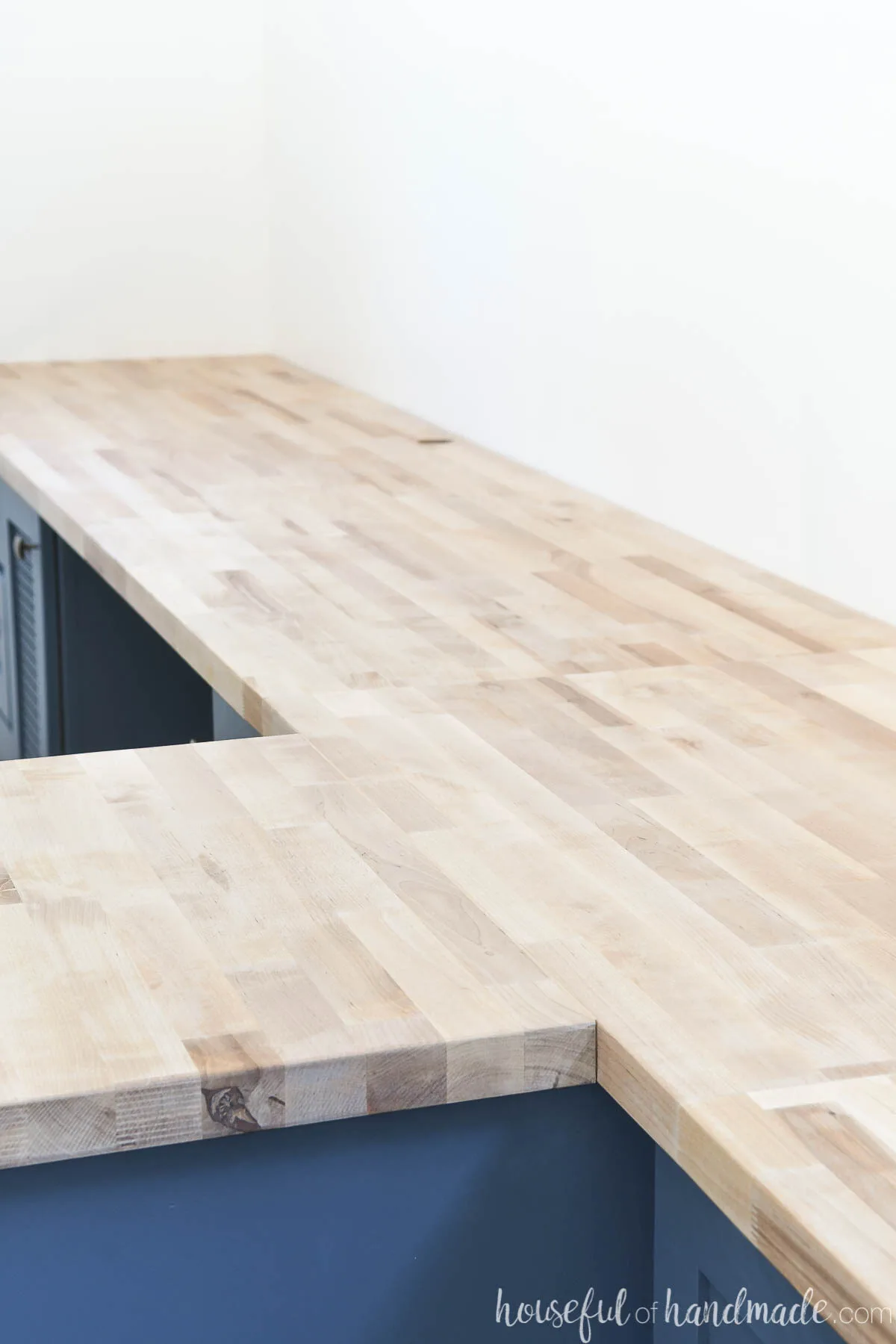
And enjoy the beautiful finish of your new butcher block countertop!

Thank you to Waterlox for sponsoring this post. I only recommend products that I use and love and all opinions are 100% my own. Click here to read my full disclosure policy.

Kimberley
Wednesday 7th of December 2022
Hi Kati! I stumbled upon your blog after watching your YouTube video on this process. It is exactly what I'm looking for. I just purchased a gorgeous acacia wood countertop to use as a desk surface. But like you, I'm scared to seal it because I don't want it darkening. So your white tung oil trick before the finish is brilliant!!
The only problem for me is that I'm located in Canada and can't seem to find the Waterlox brand anywhere. 😭 I've tried looking everywhere and no luck. I'm at a loss on what to try. I'm supposed to start sealing in the next day or two and I'm so afraid to seal with regular tung oil.
Do you happen to have any suggestions? Do you think using something like Minwax 618604444 Color Wash Transparent Layering Color, White Wash would work in lieu of the white Tung Oil? And then using a regular tung oil on top? I've even tried finding any other brand that makes matte Tung Oil but I can't seem to find any. Not sure what to try at this point. Appreciate any suggestions you may have. :)
Also, my desktop will be sitting on 2 drawer units as legs. I'm guessing it would be a good idea to seal both the top and bottom of the countertop in that case? I don't think you mentioned above whether you did the underside but I think not.
Anyway, thank again!